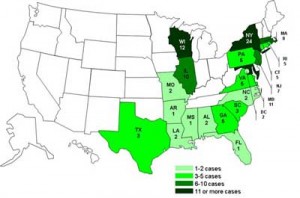The Salmonella Bareilly outbreak has now sickened 116 people in 20 states and the District of Columbia, according to the latest update from the Centers for Disease Control and Prevention (CDC) released April 11.
The update reflects an increase of 16 case patients and one state since the previous update on April 6. The new state is Florida and the new cases are from the following states: Florida (1), Georgia (1), Illinois (1), Maryland (1), Massachusetts (4), Missouri (1), New York (1), Pennsylvania (2), Rhode Island (1), and Wisconsin (3).
The total case count by state now stands at: Alabama (2), Arkansas (1), Connecticut (5), District of Columbia (2), Florida (1), Georgia (5), Illinois (10), Louisiana (2), Maryland (11), Massachusetts (8), Mississippi (1), Missouri (2), New Jersey (7), New York (24), North Carolina (2), Pennsylvania (5), Rhode Island (5), South Carolina (3), Texas (3), Virginia (5), and Wisconsin (12).
 So far, information is available from 100 case patients. Among this group, illnesses began between January 28 and March 31, 2012. The patients range in age from 4 to 78 years old. The median age of 31. Half of those who have been sickened are male and half are female. Between 12 and 14 of the case patients were hospitalized. No deaths have been reported, according to the report.
So far, information is available from 100 case patients. Among this group, illnesses began between January 28 and March 31, 2012. The patients range in age from 4 to 78 years old. The median age of 31. Half of those who have been sickened are male and half are female. Between 12 and 14 of the case patients were hospitalized. No deaths have been reported, according to the report.
Investigators are still searching for a source of the outbreak. While a definite source has not yet been identified, many of the case patients have reported eating sushi, sashimi or ofther foods made with raw fish in the week prior to becoming ill, according to the CDC’s initial report.
Salmonella Bareilly is an uncommon strain of Salmonella. As Food Poisoning Bulletin reported earlier this week, Salmonella does not naturally occur in tuna, so if that fish is a source, contamination would likely have happened at the distribution level.
Investigators are using a genetic fingerprinting technique to identify patients infected with the outbreak strain. Health officials advise those with symptoms of Salmonella poisoning, such as nausea, vomiting, fever, abdominal cramping and bloody diarrhea, to contact a health care provider.
Image courtesy of the CDC




